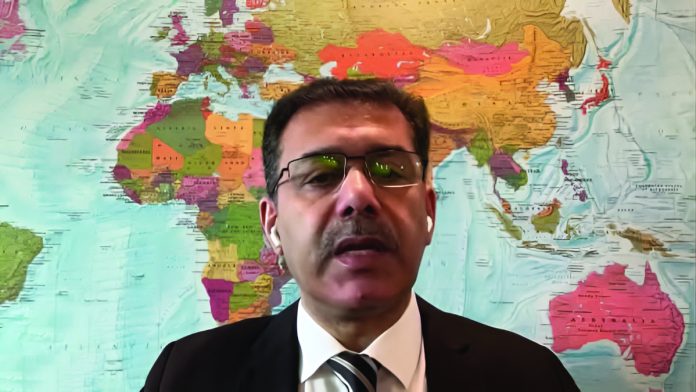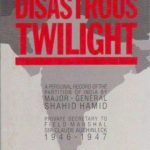NOTE: To commemorate Youm-e-Takbeera landmark day in Pakistan’s strategic history the Balochistan Think Tank Network (BTTN) hosted a webinar titled “Pakistan’s Pursuit of Credible Deterrence and Sustainable Development.” The event brought together distinguished experts and practitioners in the fields of national security, nuclear policy, and arms control.
The session was moderated by Ms. Pairman Bazai, Research Officer at BTTN, and featured prominent speakers including Dr. Ansar Parvez, former Chairman of the Pakistan Atomic Energy Commission and current Advisor (Nuclear Power) to the National Command Authority; Malik Qasim Mustafa, Director, Arms Control and Disarmament Centre (ACDC), ISSI, Islamabad; and Brigadier Dr. Zahir Kazmi, Arms Control Advisor, Strategic Plans Division (SPD). Dr. Zafar Khan, Executive Director of BTTN Quetta, delivered the concluding remarks.
In view of its strategic relevance and policy depth, Brigadier (R) Dr. Zahir Kazmi’s address is presented here in full for the benefit of scholars and readers interested in Pakistan’s national security discourse.
- Bismillahir-Rahmanir-Raheem.
- Professor Zafar Khan, respected colleagues, scholars, and the distinguished team-BTTN, Assalam o Alaikum.
- It is an honour to address this forum on “Evolving Security Dynamics of South Asia and strategic stability challenges.”
- As Balochistan’s first think tank of its kind, BTTN understands both the cost of insecurity and the importance of strategic clarity.
- Today’s seminar reflects on doctrine, deterrence, and direction under the banner of Youm-e-Takbeer. It commemorates 1998, when Pakistan affirmed its non-negotiable sovereignty through nuclear declaration. This was a doctrine of restraint and resolve, not anger or destruction.
Strategic Stability: from theory to terrain
- Ladies and Gents: strategic stability is often mischaracterized as a passive condition as the mere absence of war. I propose a new nuance: Strategic stability is restored once attempts to create space for war are prevented. Conventional deterrence is restored, and nuclear deterrence holds firm across a crisis. Miscalculation is structurally discouraged by mutual thresholds, credible signalling, and recognized red lines.
- In simpler terms: strategic stability would be an environment when both sides know the limits, respect the consequences, and are unable to escalate without facing unacceptable risk.
- If I may, there would be three interlocking foundations of stability:
- First deterrence stability: the adversary learns that you can and will respond.
- Second crisis stability: the system resists cascading into war even amid provocations.
- And thirdly, perception management: once strategic signalling is interpreted correctly, not ideologically.
- All three foundations of stability were visibly tested again in the latest crisis.
- It is here, in Balochistan, where strategic theory meets tactical reality. Because this is the region that has increasingly faced:
- Repeated Indian-sponsored terrorism,
- Psychological operations, aimed at fracturing national will,
- And hybrid warfare attempting to undermine the very logic of our deterrent stability.
- No region better understands the cost of external-sponsored instability than Balochistan. And more importantly, no other region better proves the credibility of Pakistan’s restraint.
- Today, we do not speak about South Asian security in abstraction but in acknowledgment that it is being actively challenged.
- And still, it holds, not by inertia, but by institutional design, doctrinal clarity, and national discipline.
May 2025: Crisis as stress test
- The crisis that unfolded in these two months was not an aberration. It was the latest, and perhaps most layered, expression of a strategic pattern that has become familiar in South Asia.
- Let me outline this four-stage familiar pattern:
- One: A high-visibility violent incident occurs: in this case, the second false flag operation Pahalgam. The first one occurred in 1995 and is chronicled in a book titled The Meadows.
- Two: Immediate blame is pinned on Pakistan: before forensics, before facts. Even today, neither an independent investigation nor a forensic verification has been conducted.
- Three: Civilian outrage is mobilized, aided by media choreography and disinformation amplification.
- And finally, a military operation follows, which is pre- authorized and choreographed. This time it was named Operation Sindoor.
- Now, what is different in 2025 is not just the repetition, but the symbolism. Operation Sindoor was named after a deeply rooted Hindu cultural symbol: a marker of sanctity, sacrifice, and civilizational continuity. It was not a randomly chosen title; it was strategic semiotics.
- It sought to reframe deterrence into dharma and to recast force posture as cultural redemption.
- And with that, India collapsed the boundary between security doctrine and ideological ambition.
- Such naming is not unprecedented. But when this symbolism is used to cloak kinetic escalation, strategic signalling itself becomes distorted. That is not deterrence. It is theatrical escalation.
- I say this is not to equate religious symbolism with aggression. It is to ask that all civilizational references whether Dharmic or Abrahamic be interpreted contextually, not selectively.
Pakistan’s response: QPQ+ in action
- Ladies and Gents: Pakistan, by contrast, neither mimicked the mythology nor played into the provocation.
- Instead, we invoked Operation Bunyanum Marsoos, which was derived from Surah As-Saff, evoking a defensive wall, united and unshaken. This was not theology as theatre. It was a strategic metaphor denoting resilience, cohesion, and moral posture under fire.
- Our response:
- Targeted only military infrastructure,
- Remained inside the conventional envelope, and
- Was anchored in Article 51 of the UN Charter the right to self-defence.
- Let me be clear: We did not retaliate. We responded and response implies proportionality, legality, and clarity of objective.
- This is the essence of Quid Pro Quo Plus (QPQ+), a doctrinal logic, not an improvisational move.
- QPQ+ serves three stabilising functions:
- Denies India the escalatory upper hand by demonstrating credible, ready, non-nuclear options.
- Affirms that Pakistan retains control over firebreaks between conventional and nuclear realms.
- Shows the world that Pakistan restores stability, it does not unhinge it.
Crisis stability by design, not delay
- During the recent crisis, the Nuclear Command Authority was not convened. Why? Because our conventional deterrent held. The Pakistan Air Force aircraft and Fatah-series systems, backed by precision ISR and doctrinal clarity, sufficed.
- This is not an accident. It is institutional evolution. In 1998, we demonstrated deterrence. In 2019, we demonstrated conventional flexibility. In 2025, we demonstrated crisis maturity without theatre and without threshold blur. This is strategic stability restored not by chance, but by choice.
Strategic stability under perception distortion
- Ladies and Gentlemen: Strategic stability does not collapse only due to military missteps. It erodes, quietly but perilously, through perceptual distortions, narrative asymmetry, and misreading of deterrent signalling.
- Let me offer two conceptual frames that help explain South Asia’s fragile equilibrium today.
- First, the Pretext Architecture. Over the past decade, India has developed what I call a pretext architecture: a scripted sequence through which aggression is made to appear as justified self-defence. The cycle is predictable:
(1) It begins with violence or so-claimed terrorism incident: often unresolved or suspicious,
(2) That leads to instant attribution to Pakistan without forensics or evidence,
(3) Then, there is disinformation surge across official media, bot networks, and diplomatic echo chambers,
(4) Which escalates to pre-authorised military action that’s framed as “inevitable” rather than discretionary.
Examples include the Uri incident in 2016: no independent verification followed by swift escalation. Pulwama 2019: forensic protocols bypassed. Pahalgam 2025: second false flag in that location in 30 years in which forensic investigation still suspended, yet airstrikes, missile strikes and drone strikes were launched.
(5) This architecture converts accusation into authorization. And that is dangerous. Because when narrative becomes strategy, escalation becomes habitual.
- The second conceptual frame is that of Compressed Stability. South Asia is not a region of wide buffers. Here, conventional and nuclear thresholds exist in compressed proximity geographically, politically, and doctrinally. I call this compressed stability: a condition in which small tactical events a drone misfire, a foggy radar contact, or a cross- border skirmish can rapidly touch strategic nerves. In such a context:
(1) A pretext-driven military act can spiral.
(2) A misread signal can trigger panic preparedness.
(3) A civilian casualty can distort strategic calculus.
- Our crisis behaviour, which I prefer to call Pakistan’s doctrine of firebreak preservation, involves deliberately maintaining space between conventional and nuclear operations. This strategy is both moral and stabilizing.
Misreading restraint as weakness
- One of the more dangerous trends in global strategic commentary is the misinterpretation of Pakistani restraint as hesitation, or worse, incapacity.
- Let me be very clear:
- Pakistan’s calibrated response was not a crisis improvisation.
- It was a product of doctrinal clarity, strategic confidence, and institutional preparedness.
- If Pakistan had reacted disproportionately, we’d be blamed for escalating. If we act proportionately, we’re labelled as reactive or symbolic.
- This analytical inconsistency not only misinforms policy. It incentivizes risk-taking by the adversary who begins to believe it can provoke without consequence. That is not a South Asian problem. It is a global one. Because strategic stability cannot survive if bias replaces balance, and narrative replaces norms.
The unfinished core: Kashmir is not a footnote it is the Faultline
- Distinguished colleagues: No serious discourse on strategic stability in South Asia can claim coherence if it ignores the single most persistent source of structural instability: the unresolved dispute over Jammu & Kashmir.
- The May 2025 crisis, like those of 2019, 200102, and even Kargil, did not emerge in a vacuum. It began, again in Kashmir. A high-visibility incident in Pahalgam was rapidly politicised, never independently investigated, and swiftly converted into a pretext for escalation.
- This was not coincidence. It was a patterned provocation.
- Let us be unequivocal:
- Kashmir is not a tactical irritant; it is the strategic Faultline.
- The denial of the right to self-determination is not only morally untenable; it is strategically corrosive.
- Demographic engineering, civic dispossession, and prolonged information blackouts do not contain volatility they incubate it and give momentum to the legitimate armed-freedom struggle.
- Strategic stability cannot be managed around Kashmir. It must be built through its just resolution. As long as UN Security Council resolutions remain unimplemented, fundamental freedoms in the Valley are suspended, and narrative provocations are cloaked in civilizational language drawn from Hindutva ambition; the region will remain not just a theatre of deterrence, but a tinderbox of instability.
- Deterrence is a product of thresholds. But illegal occupation moth- eats thresholds and erodes them.
- And so, if strategic stability is to be more than episodic; if it is to be real, durable, and just; Kashmir must move from the margins of discourse to the centre of resolution.
Lessons for the international community
- To our international partners and strategic observers, three lessons emerge from this crisis:
- First Strategic Literacy Must Replace Selective Sympathy
(1) When India invokes Vedic metaphors, it is seen as culture.
(2) When Pakistan invokes Quranic metaphors, it is often cast as ideology.
(3) This asymmetry is not academic. It shapes strategic misreading, fuels biased threat assessments, and influences policy miscalculations.
(4) We are not asking for indulgence. We are asking for interpretive equity.
- Second lesson – False Flags Are Not Fiction They Are Strategic Traps
(1) The world must stop treating false flag operations as fringe claims or conspiracy rhetoric. History has repeatedly and chillingly shown us otherwise.
(2) From the Gleiwitz incident in 1939, where Nazi operatives staged an attack on a German radio station and blamed it on Poland, using it as a pretext to launch World War II…to the Gulf of Tonkin incident in 1964, where exaggerated or false reports of North Vietnamese attacks were used to justify full-scale U.S. military escalation in Vietnam…
(3) In both cases, fabricated or manipulated incidents became the triggers for immense geopolitical consequences: wars, occupations, and irreversible human loss.
(4) False flags are not theories. They are historically documented strategies used to manufacture legitimacy for pre-planned military action while discrediting the targeted state.
(5) In South Asia, we must learn from this pattern, not repeat it. The international community cannot afford to remain agnostic when such patterns re-emerge, whether it is Pulwama in 2019 or Pahalgam in 2025. Silence or selective scrutiny not only legitimises these acts; it structurally endangers strategic stability.
(6) Strategic restraint without investigative accountability is not peace. It is vulnerability.
(7) Pahalgam demands an impartial, UN-supervised forensic investigation.
(8) Strategic stability cannot survive if fabricated justification is rewarded with geopolitical indulgence.
- Third lesson – is that Deterrence Without Dialogue Is Delusion
(1) Pakistan has upheld its end: It has responded with QPQ+, not impulsive overreach. It has preserved the nuclear firebreak. It has communicated in legal, diplomatic, and proportionate terms.
(2) But no doctrine, however refined, can indefinitely contain instability born of unaddressed political disputes.
(3) If the global security architecture is serious about South Asia, it must invest in political resolution, not just crisis management.
What the world must understand
- This brings us to the global dimension of stability. For those watching South Asia from the outside analysts, allies, or scepticsI offer three takeaways:
- First – Narrative Discipline Is Strategic Discipline
(1) If Hindu civilizational references like Sindoor are deemed cultural, while Pakistan’s Quranic metaphors like Bunyanum Marsoos are framed as ideological, then we are not practicing analysis. We are reproducing prejudice.
(2) Misreading symbols distorts threat perceptions, and makes restraint seem radical.
(3) This is not to equate religious symbolism with aggression. It is to ask that all civilizational references, whether Dharmic or Abrahamic, be interpreted contextually, not selectively.
- Second – take away Stability Requires Norms, Not Performances
(1) If India’s pretext-driven strikes are lauded as restraint and Pakistan’s calibrated response is labelled reactionary, we incentivize destabilization.
(2) Strategic maturity must be judged by conduct, not by commentary tone.
- Third take away Kashmir Is Not a Side Dispute. If international actors treat Kashmir as an “issue” instead of the epicentre of regional instability, they are misreading the map and the minefield.
Conclusion: strategic stability as a test of global discernment
- Ladies and gentlemen: As we mark Youm-e-Takbeer, we do more than commemorate a date. We reaffirm a doctrine.
- Takbeer was not a cry of aggression. It was a declaration of sovereign clarity. It told the world: Pakistan will never again allow its peace to be held hostage by strategic coercion.
- But Takbeer must walk with Tawazun (with balance). And Tamkin (composure, control, and command), which shapes our posture in every crisis.
- In the May 2025 confrontation, Pakistan showed exactly that. We did not just respond. We restored stability.
- We did not cross red lines. We reaffirmed them for ourselves and for the region. But stability is not sustained in a vacuum; it is not a solo aria. It requires that those who observe it also understand it.
- This leads me to a crucial reminder: The world must stop treating false flag operations as fringe claims or conspiracy rhetoric. History has repeatedly and chillingly shown us otherwise. From the Gleiwitz incident in 1939 to the Gulf of Tonkin incident in 1964, manufactured pretexts led to devastating wars.
- False flags are not fiction. They are historically validated tactics used to mobilize public sentiment, shield political motives, and cloak aggression in moral legitimacy. In South Asia, we must learn from this pattern, not excuse it.
- Pulwama was not investigated. Pahalgam remains deliberately opaque. And yet, in both cases, military actions followed choreographed narratives.
- The international community must not treat strategic manipulation as diplomatic grey zones. It must demand forensic transparency, apply narrative discipline, and hold all actors to the same evidentiary standards. Because without that, restraint becomes a one- sided virtue and stability, a temporary illusion.
- To our global partners: Do not judge Pakistan by the volume of its critics, but by the validity of its conduct. We do not seek escalation dominance. We seek deterrence credibility. We do not blur thresholds. We protect them with doctrine, not drama.
- To our adversary: May 2025 was not a one-off. It was the reaffirmation of a strategic principle that every provocation will be met not with panic, but with proportionality. Not with slogans, but with strategy.
- And to the youth of Balochistan and across Pakistan: You do not inherit just a nuclear program. You inherit a posture; built with care, operated with caution, and maintained with resolve. Your duty is not just to defend borders, but to defend balance. Because in your generation lies the future of Pakistan’s strategic sobriety, its ability to lead with clarity, not chaos.
- Let us honour the spirit of Takbeer but live by the wisdom of Tamkin.
- In South Asia and elsewhere, let’s keep balance not only in our arsenals but also in our ambitions.
Pakistan Paindabad.










